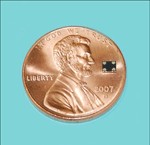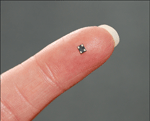MEMS generation takes its place beside quartz
Silicon oscillators now offer quartz oscillator performance at a lower cost
BY DOUGLAS GLENN CLARK
Ecliptek, Costa Mesa, CA
http://www.ecliptek.com
For decades an accurate oscillator using a silicon resonator remained an elusive technological dream as research revealed its potential as an alternative to quartz oscillators without actually proving its worth. Recent MEMS (micro-electro-mechanical systems) resonator breakthroughs, such as improved long-term frequency stability and thermal hysteresis, have convinced some design engineers and management teams that the new technology’s day has come.
Since World War II, quartz crystal resonators have been the standard in the frequency-control arena because of their piezoelectric and mechanical properties. There have been other contenders, such as ceramic, silicon, and RLC resonators. However, none could match quartz resonators due to their superior temperature stability, thermal hysteresis, and long-term stability.

But quartz crystal resonators do have some limitations. They cannot suitably be integrated onto silicon CMOS wafers, their cost significantly increases when their package volume decreases, and they are vulnerable to performance degradation when subjected to more severe levels of shock and vibration.
Faced with these concerns and growing demand — in 2007 more than an estimated 10 billion quartz crystals and oscillators were manufactured — the electronics industry has funded MEMS resonator research for more than four decades with the hope of developing frequency-control products that in some applications could replace quartz crystal oscillators without sacrificing quality or performance.
Overcoming hurdles
In the past, reliable performance comparable to quartz was a big hurdle for MEMS timing products to overcome. MEMS resonators did not exhibit good temperature stability, thermal hysteresis, and long-term stability. Now that these issues have been solved, firms like Ecliptek have embraced the fast-growing MEMS resonator timing market. Ecliptek now offers the EMO product family of programmable oscillators. The EMO family of oscillator products includes 12 different product series encompassing four industry standard package sizes and three supply voltages (1.8, 2.5, and 3.3 Vdc), providing frequency stabilities of ±50 ppm max over an operating temperature range of −40° to 85°C.
The MEMS clock oscillators provided by Ecliptek contain a MEMS resonator, an oscillator stage, frequency-temperature compensation, a low-noise phase-locked loop, and a tri-state output buffer stage. A 200-mm CMOS wafer fabrication process for reduced lot-to-lot MEMS resonator variation, industry standard QFN (quad flat no-lead) packaging, and a COL (chip on lead) assembly process improves reliability while reducing assembly costs. This outcome compares well to quartz, which can not take advantage of these manufacturing techniques and processes due to its mechanical structure.
Timing is everything
Reduced inventory-carrying costs and time to market are the key reasons why the use of MEMS oscillators is on the rise. Manufacturers can now offer MEMS oscillators with a shorter lead time than either quartz fixed-frequency oscillators or quartz programmable oscillators. By narrowing the delivery window, a company limits its liability from a time and financial perspective. And the faster delivery does not come with a higher unit cost. MEMS oscillators are available in high volume with competitive prices.

Reduced inventory-carrying costs and time to market are the key reasons why the use of MEMS oscillators is on the rise.
Some industry insiders say it may be premature to laud MEMS-based oscillators. They argue that no new product in any industry becomes the leader until it has been swept up in a wave of “consumerization.”
This means the MEMS-based oscillator movement cannot afford to take anything for granted. To catch the speed of the changing consumer-product wave, MEMS companies must develop manufacturing techniques and processes that allow them to further reduce the package volumes of these already small devices. And the products must be available in even higher volumes with still yet quicker delivery times.
Even so, an expert in the field believes the future will grow brighter as MEMS is integrated directly with CMOS. Integration will yield many benefits in continuous size reduction, better performance, and less manufacturing complexity. The overwhelming size advantage of MEMS solutions will provide an avenue for further size reductions in wireless nodes and multichip modules — and lead to the elimination of quartz from the PCB altogether.
New levels of performance, which rival quartz, have already taken MEMS programmable clock oscillators into new markets. And buyers agree that MEMS improves the bottom line for firms eager to grow while going small.
For more on oscillators, visit http://electronicproducts-com-develop.go-vip.net/Passive.aspx.
Advertisement
Learn more about Ecliptek





